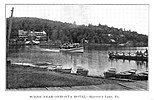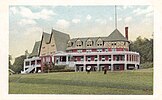Harveys Lake (Pennsylvania)
| Harveys Lake | ||
|---|---|---|
| Harvey Lake, Harvey's Lake | ||
Primary inflows two unnamed streams, several springs | | |
| Primary outflows | Harveys Creek | |
| Catchment area | ~3,600 acres (1,500 ha) | |
| Basin countries | Luzerne County, Pennsylvania; Wyoming County, Pennsylvania | |
| Max. length | 15,640 feet (4,770 m) | |
| Max. width | 4,960 feet (1,510 m) | |
| Surface area | 621.5 acres (251.5 ha) | |
| Average depth | 36 feet (11 m) | |
| Max. depth | 102 feet (31 m) | |
| Water volume | 7.733 billion US gallons (6.439×109 imp gal; 29.27 hm3) | |
| Residence time | 1116 days | |
| Shore length1 | 8.3 miles (13.4 km) | |
| Surface elevation | 1,253 feet (382 m) | |
| 1 Shore length is not a well-defined measure. | ||
Harveys Lake (also known as Harvey Lake or Harvey's Lake[1]) is a natural lake in Luzerne County, Pennsylvania. It has a surface area of approximately 621.5 acres, or nearly a square mile. The lake is situated entirely within the borough of Harveys Lake.[2][3] By volume, it is the largest natural lake in Pennsylvania, and by surface area, is the second-largest lake. It is a glacial lake surrounded by hills and is the source of Harveys Creek, a tributary of the Susquehanna River. The lake has a stone masonry dam. The lake's watershed has an area of approximately 3600 acres. The majority of the watershed is forested, but there is some developed land as well. Nearly all of the developed land is close to the lake itself, and the lake is surrounded entirely by a paved road.
Harveys Lake was affected by
Harveys Lake was accidentally discovered by Benjamin Harvey in 1781. The first settlers arrived at the lake in the 1790s and 1800s. Early industries in the area included lumbering and farming, but it became well known as a summer resort in the latter part of the 1800s and into the 1900s. It was also used as a water supply in the early 1900s. However, the lake began to develop significant environmental problems in the 1960s and a total maximum daily load was created for it in 1994. Since 1968, the lake has been located in the borough of Harveys Lake.
Geography

Harveys Lake is the largest natural lake in Pennsylvania by volume and the second-largest by surface area.[3][4][5] It has a surface area of 621.5 acres and an average depth of 36 feet (11 meters),[3] as well as a maximum depth of 102 feet (31 m).[5] The lake's shoreline is 8.3 miles (13.4 km) long.[6] By surface area, it was approximately twice its current size when it was first surveyed in the late 1700s.[7]
Harveys Lake is situated in the borough of Harveys Lake,[2] and it is 12 miles (19 km) northwest of the city of Wilkes-Barre.[7]
Harveys Lake is of glacial origin.[8] It is surrounded by steep hills on all sides. At their highest point, to the south of the lake, the hills reach 410 feet (120 m) above the lake's elevation.[5] The lake has a gravel bottom.[7]
The main outflow of Harveys Lake is Harveys Creek, a tributary of the Susquehanna River.[2][4] The lake's major inflows include two unnamed streams with widths between 4 and 8 feet (1.2 and 2.4 m) and depths of 6 inches (15 cm). Springs also feed into it.[5] The lake's elevation is 1,253 feet (382 m) above sea level.[1] The lake is located in north-central Luzerne County, in the Lower North Branch Susquehanna drainage basin and the Upper Susquehanna - Lackawanna basin.[5][9]
A 1921 book described the shape of Harveys Lake as "very irregular". The lake has a maximum length of 15,640 feet (4,770 m) and a maximum width of 4,960 feet (1,510 m). It has a capacity of 7.733 billion US gallons (29.27 million cubic metres). Harveys Lake is dammed by a stone masonry dam with two spillways. The dam is 120 feet (37 m) long and 4 feet (1.2 m) high.[5]
Harveys Lake was described as "one of the most beautiful" lakes in Pennsylvania in Henry C. Bradsby's 1893 book History of Luzerne County, Pennsylvania.[7]
Watershed


Harveys Lake is situated in the United States Geological Survey quadrangles of Harveys Lake and Noxen.[1] The watershed of the lake has an area of 3,600 acres (1,500 ha).[3][4] Most of the watershed is in Luzerne County, but its northeasternmost portion is in Wyoming County.[9]
The vast majority (2,841 acres [1,150 ha]) of the watershed of Harveys Lake is
The shoreline of Harveys Lake is entirely surrounded by a paved road, which is atypical for a lake shoreline. Homes and cottages are situated on the road opposite the lake,[3] and significant development has occurred in the vicinity of the lake.[11] A ditch and outlet drainage structure made of concrete at Wardens Place drains into the lake; its purpose is to control small-scale local road flooding.[12]
Hydrology
Although Harveys Lake's waters were described as having "great purity" in 1893, the lake has experienced nutrient pollution, especially from phosphorus since at least the mid-20th century.[3][7] Algae blooms occurred on the lake and caused a reduction in water quality throughout the latter half of the 20th century. A sewage system was installed in the borough of Harveys Lake in the summer of 1976, but this did not completely stop the algae blooms.[9] However, the phosphorus load in the lake has been reduced by 29 percent.[4] The lake was identified as impaired in 1994, with the cause of the impairment being large algae blooms and sedimentation in some areas. It is an anoxic lake.[3]
In the 1990s, the concentration of phosphorus in the waters of Harveys Lake was measured to be 0.031 milligrams per liter. The annual load of phosphorus was 1,019 pounds (462 kg) per year. The lake's total maximum daily load for phosphorus is 0.024 milligrams per liter and 789 pounds (358 kg) per year.[3]
In the 1990s, 255 pounds (116 kg) of the annual phosphorus load of Harveys Lake came from
The
History and recreation

Harveys Lake was entered into the Geographic Names Information System on August 2, 1979. Its identifier in the Geographic Names Information System is 1200085.[1] Lake Township is named after the lake.[7]
Harveys Lake is named after Benjamin Harvey, a member of the Sons of Liberty and among the first settlers of the Wyoming Valley. Harvey inadvertently discovered the lake in 1781, while returning home after being held as a prisoner of war in Fort Niagara.[8] The first resident in the vicinity of the lake was Matthew Scouten, who arrived in the early 1790s, but the first settlers were the Worthingtons, who arrived in 1806.[8] The lake was first surveyed by Christopher Hurlbert in 1794, and the first person of European descent to explore the lake by canoe was Andrew Bennett, in 1800.[7]
The early settlers in the vicinity of Harveys Lake mainly engaged in lumbering and farming, which was a common occupation.
The Harvey Lake and Towanda Branch of the Lehigh Valley Railroad was constructed in the late 1800s. It ran directly from Wilkes-Barre to Harveys Lake. In the 1890s, railroad lines were constructed from the lake to the communities of Pittston and Towanda.[7]
Harveys Lake has been popular for recreational purposes since the late 1800s.
In the early 1900s, Harveys Lake was used as a
Harveys Lake has been the subject of scientific studies since the late 1940s, when C. B. Reif conducted
In modern times, the main recreational uses of Harveys Lake include swimming, fishing, and boating.
Historical gallery
-
A view of the east side of Harveys Lake, ca 1907.
-
Steamboat Excursion, ca 1910.
-
Steamer NA-TO-MA, ca 1910.
-
Harveys Lake Trolley Station, ca 1912.
-
Hotel Oneonta, ca 1915.
-
Hanson's Amusement Park, ca 1930.
-
Our Lady of Victory Chapel, ca 1940.
-
Sandy Beach, ca 1940.
Biology
Harveys Lake is listed on the Luzerne County Natural Areas Inventory.[11]
Numerous rare or endangered plant species have been observed in the vicinity of Harveys Lake. Plants in the vicinity of the lake include
Harveys Lake is inhabited by various species of native
Various
See also
- Raystown Lake, the largest reservoir in Pennsylvania
- Conneaut Lake, the largest natural lake in Pennsylvania by surface area
- List of lakes in Pennsylvania
References
- ^ a b c d Geographic Names Information System, Feature Detail Report for: Harveys Lake, retrieved February 2, 2015
- ^ a b c United States Geological Survey, The National Map Viewer, retrieved February 2, 2015
- ^ a b c d e f g h i j k l m n o Pennsylvania Department of Environmental Protection (March 1, 2002), Harveys Lake TMDL (PDF), retrieved February 2, 2015
- ^ a b c d e United States Environmental Protection Agency, Harveys Lake, Pennsylvania – Nonpoint Source Success Story, retrieved February 2, 2015
- ^ a b c d e f g h i j Water Supply Commission of Pennsylvania (1921), Water Resources Inventory Report, pp. 80–81
- ^ a b c Bloomsburg University SCUBA Club, Harveys Lake Diving, archived from the original on March 3, 2016, retrieved February 2, 2015
- ^ a b c d e f g h i Henry C. Bradsby, ed. (1893), History of Luzerne County, Pennsylvania, pp. 29, 262, 597–598
- ^ a b c d e f g h i j k l Harveys Lake Borough, History of Harveys Lake, retrieved February 2, 2015
- ^ a b c d e f g h Princeton Hydro, LLC. (March 2010), Prioritization of BMPs and Implementation of Watershed Projects for Harveys Lake (PDF), retrieved February 2, 2015
- ^ a b Fred S. Lubnow, John A. Miller, The Design and Installation of an Innovativ Best Management Practice Structure to Reduce the Annual Phosphorus Load to a 633 acre Lake in Northeastern Pennsylvania (PDF), retrieved February 3, 2015
- ^ a b c Pennsylvania Natural Heritage Program, Western Pennsylvania Conservancy (2006), A NATURAL AREAS INVENTORY LUZERNE COUNTY, PENNSYLVANIA Update – 2006 (PDF), p. 111, retrieved February 2, 2015
- ^ a b Federal Emergency Management Agency, Flood Insurance Study VOLUME 1 of 6 LUZERNE COUNTY, PENNSYLVANIA (ALL JURISDICTIONS) (PDF), p. 35, archived from the original (PDF) on April 2, 2015, retrieved February 2, 2015
- ^ ISBN 9780738562780
- ^ Camille Fioti (November 23, 2004), "Dredging plan hits opposition: Dep hears public input on the proposed developing of a wetlands area in Harveys Lake", Times Leader, retrieved February 3, 2015
- ^ Field & Stream, February 1972, p. 117
- ^ Pennsylvania Fish and Boat Commission (October 2009), Strategic Plan for Management of Trout Fisheries in Pennsylvania 2010 - 2014 (PDF), p. 50, archived from the original (PDF) on March 4, 2016, retrieved February 3, 2015
- ISBN 0801436435








